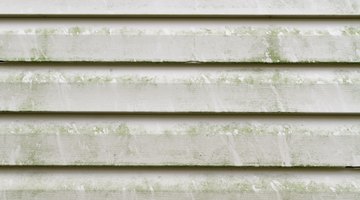How to Remove Mold From Vinyl Siding
Mold and mildew are basically two words for the same thing, and cleaning them from the side of a house is usually easy with a power washer. That technique is problematic when cleaning vinyl siding, though, because a pressure washer can force water under the siding.

That doesn't mean you can't use a pressure washer, but you have to keep the pressure low, so you should scrub the siding with a solvent first.
Using a Pressure Washer on Vinyl
Not all vinyl siding manufacturers recommend pressure washing their products, so it's best to check first to avoid voiding the warranty. Once you're sure it's OK, adjust the pressure to no more than 1,200 psi and fit the wand with a 40-degree nozzle. At that pressure, you may have trouble removing well-established patches, especially from high places that require you to work from a ladder. For this reason, it's a good idea to scrub with a disinfecting cleaner and rinse with the pressure washer. Remember to keep the wand horizontal or tilted downward to avoid forcing water under the vinyl slats.
Mold Cleaning Solutions
Bleach has long been the go-to cleaner for mold, because chlorine kills mold on contact. You don't need a strong solution -- the recommended proportions are 1 part bleach to 10 parts water, or about 1/2 cup of bleach per gallon of water. An alternative for light mold and mildew is a solution consisting of 30 percent vinegar and 70 percent water, or about 1 1/2 cups of vinegar per gallon of water. Both bleach and vinegar can harm plants and foliage, so if that is a concern, mix 1 cup of oxygen bleach per gallon of water instead. Add a cup of laundry detergent to any of the 1-gallon water mixtures to increase the cleaning power.
Scrubbing the Siding
Mold removal usually requires some scrubbing, and the best tool to use is a stiff-bristle, natural-fiber scrub brush. Avoid metal-fiber brushes -- they can damage the siding. Scrub with moderate pressure, being careful not to push too hard against the flexible vinyl, which can break. Using a scrub brush on the end of a long pole will help you avoid the need to climb to the top of the ladder to reach under the eaves. If you're working in dry weather, wet the siding down with a pressure washer or garden hose before scrubbing to loosen the grip of the mold.
Rinsing with a Pressure Washer
Pressure washing is more effective if you do it while the mold is still wet from scrubbing. Start at the top of each wall and work your way down, holding the tip of the wand at least 12 inches from siding to avoid applying too much pressure. While you're on a ladder, avoid pointing the tip at the siding at the moment that you pull the trigger, because the initial blast may force you to lose your balance. After you've pressure washed the wall, examine it carefully and repeat the cleaning procedure if you still see mold.
The Drip Cap
- Mold and mildew are basically two words for the same thing, and cleaning them from the side of a house is usually easy with a power washer.
- Mold removal usually requires some scrubbing, and the best tool to use is a stiff-bristle, natural-fiber scrub brush.
- Avoid metal-fiber brushes -- they can damage the siding.
- Start at the top of each wall and work your way down, holding the tip of the wand at least 12 inches from siding** to avoid applying too much pressure.
- While you're on a ladder, avoid pointing the tip at the siding at the moment that you pull the trigger, because the initial blast may force you to lose your balance.
References
Writer Bio
Chris Deziel has a bachelor's degree in physics and a master's degree in humanities. Besides having an abiding interest in popular science, Deziel has been active in the building and home design trades since 1975. As a landscape builder, he helped establish two gardening companies.
Photo Credits
- Scott Nodine/iStock/Getty Images
- Scott Nodine/iStock/Getty Images
More Articles


